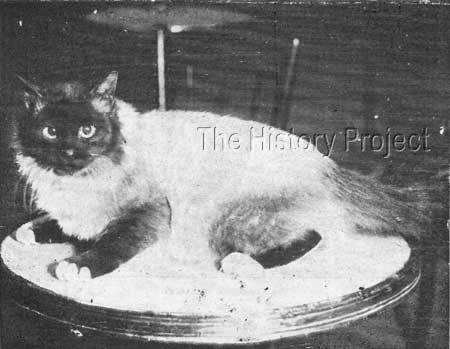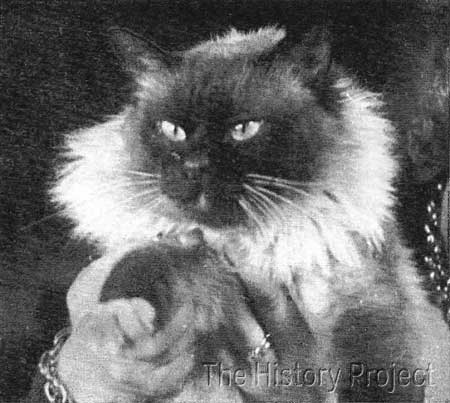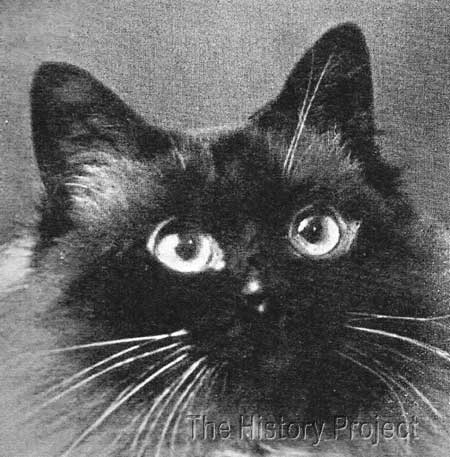 | ||||||||||||||||||









|
DIEU D'ARAKAN (1930)PHOTOS | SOCIAL MEDIA | REFERENCES | PDF FILE (Felis Historica)
HISTORICAL BACKGROUND:In the history of the Birman as a breed, 'Dieu d'Arakan' stands as the probably the most significant pre-war Birman cat of recognisable quality, especially when you consider that his foundation forebears arrived in France a mere ten years before his birth, and the breed, by necessity, had been subjected to outcrossing to Siamese and possibly other breeds in order to ensure its survival. 'Dieu d'Arakan's' overall type was so demonstrably ahead of his time that he became, almost by default, the hallmark standard-bearer for the future of the breed. His appearance simply raised the bar for 'type' to new levels, and once seen, every Birman breeder of note wished to emulate his looks within their own breeding programs. He had the shape, the coat, the markings and the eye colour. In short, they didn't come any better than this. Here was a Birman cat that could proudly stand beside all-comers in other breeds and be recognised as distinctly unique, with an air of quality that was unparalleled within the breed up until that point in time. PARENTAGE & OWNERSHIP:
Unknown
Unknown
| Unknown
Eur Ch Dieu D'Arakan, 1930, Seal Point Birman, M
| Unknown
Unknown
Unknown
'Dieu d'Arakan' was born in 19301. His breeder was Marcel Baudoin-Crevoisier, who had a short but meteoric rise to fame as one of the most prominent breeders of Birmans between 1929 and 1933. He had purchased two early high fliers in 1929. Gisele Barnay refers: "If one continues the tour of the cat shows of the era, one sees the arrival of other stars. There were two more 'show' cats in 1929 in Paris: one at the Cat Club show on the 8th-9th February and the other at the Central Feline Society show on 24th-26th May. They were a couple of Birman cats unique in the world on account of their perfection. This referred to 'Ijadi Tsun', a female cat and the male 'Lon Saito', born in 1927, when Marcel Baudoin became their owner."1 The image below is of an admirable seal point Birman, who must date from around 1927 or 1928 as the photograph was selected by Dr. Phillipe Jumaud for publication in the 1930 edition of his thesis, Les Races De Chat3. Although as yet, the author has not found any other contemporary reference to Madame Brassart, it is clear that her cats were of recognised quality to be chosen to represent the breed in Dr. Jumaud's book. This cat, appears to be in the limelight at much the same time as Marcel Baudoin's new male, 'Lon Saito of Madalpour'. It should be noted that there are no firm records for the parentage of 'Dieu d'Arakan'. But given that Monsieur Baudoin-Crevoisier owned 'Lon Saito of Madalpour' and 'Ijadi Tsun' at the time, one cannot but wonder if these two were not involved in the production of such a fine specimen.
Simone Poirier and Gisele Barnay both allude to Baudoin possibly introducing Persians into the mix as they felt that the style had changed from what was a distinctly 'siamese' cross appearance with long hair, to a more rounded, heavier bult look, more consistent with outcrossing to longhairs. Gisele Barnay also noted that the coats had improved considerably. Poirier commented: "1929 was the year when Baudoin began to work seriously on the breed. He mever made any secrets of avoiding 'too many incestuous unions' he made 'lucky outcrosses with some Siamese females with white gloves and some stud-cats of Madalpour's line' but never admitted that he had called in some Persians."1 to which Giselle Barnay then adds: "Upon seeing the results in the following years, it is undeniable! In the photos, the cats of Marcel Baudoin-Crevoisier have a head distinctly more rounded and fur much longer than found with other breeders."1 She then asks Poirier: "have you never had the chance to meet him and ask that question?"1 In her response she reveals: "When I asked him the question: 'What did you use use for your breeding?' he replied 'a Siamese, gloved and with long fur'"1 then she added later "..he responded to all my explicit questions in an evasive manner, clouding the trail. He was bizarre; he stuck to the history, always gliding over any doubts of their origin. I could not get any clear answers."1
But regardless, Poirier did not question the value of the results of Baudoin's efforts. She concluded: "There is no doubt that Baudoin had done a good job, with an intelligent breeding program that he continued to use. The original Madalpour lione from which his stud 'Lon Saito' cam was good. The descendants of 'Poupee' had been produced using regular blood relations with the intervention of Siamese cats, certainly gloved and probably with long coats. It was a prudent and controlled intervention, since the gloves were inherited by the new generations. Baudoin continued to 'frequently renew the blood of the breeding cats'. He write that but he certainly did not tell how!"1 Giselle Barnay added: "Baudoin also specified that the Siamese and the Birman cats share their origins and he added 'a crossed Birman and a gloved Siamese produced, in the second generation, a stong proportion of Birman characteristics. And these cats, from new crosses between themselves, produced kittens with at least 80-90% Birman characteristics.' Perhaps he was lucky." CHANGES IN OWNERSHIP Despite his considerable successes on the show bench before and during 1932, and whilst French cat breeding continued to improve, gained status, Baudoin appears to have become discouraged. Barnay tells us that in June, 1932, he wrote that his financial affairs were difficult and that cat food was expensive etc. In 1933, he decided to sell the whole of his breeding stock. Two cats were purchased by the Swiss Siamese breeder, Abbott Marcel Chamonin (who wrote passionately about the Birman cat under the pseudonym of 'Marcel Reney'). These were 'Rose de Mogock', the daughter of Bijou de Madalpour and 'Poupee de Rangoon', the daughter of 'Rose de Magock'1. This same Marcel Chamonin had organised the first cat shows in Switzerland at the beginning of 1933, with the permission of the Cat Club of Paris and the Cat Club of Champagne. At the time of the purchase, he was the general secretary of the Cat Club of Geneva, which became independent considerably later, in 1952. He was also a judge of the International Federation of Cats in Switzerland and loved his cats enormously.1 Barnay informs us that two other Champions bred by Baudoin were sold in Belgium, to Mlle Rouselle, the general scretary of the Cat Club of Liege. These were 'Lon Saito de Madalpour' born in 1927, and 'Zaquelle de Mandalay' born in 19311. According to Marcel Chamonin (Reney), Baudoin sold the remainder of the cats to the Italian Princess Ratibor Honenlohe in 1933 for the sum of 30,000 francs. At that time, she was living at Satirana castle, at Lomellina-Pavie1. She, in turn, had given them to the Duke of Aoste. Finally they ended up at the Francecavilla-Bisio Castle, the home of a cousin of the Duke, the Countess Elisabetta Giriodi-Panissero, who appears to have loved the animals a great deal.1 Barnay gives further illumination: "When she (the Countess) died in January 1985, she did not own a single cat, but always had about thirty dogs. Mme Norma Bagnasco, still responsible for the bursar's office at the Francavilla castle in 1987, was a little girl just before the Second World War. She did not remember 'Dieu d'Arakan', maybe he had died, because he had been very ill but she recalled perfectly 'Regina de Rangoon' and she had seen the medals won at shows in times past, by the two champions of beauty. The servants and gardeners had been responsible for looking after the cats."1 SIBLINGS & SHOWS:Although it is likely that Monsieur Baudoin would have bred full and/or half siblings to 'Dieu d'Arakan', there are no records which can be tapped to confirm this. We do know that he bred from related lines, but to affirm that any of these were in fact siblings could only be based on conjecture. SHOWS: 'Dieu d'Arakan' appears to have first been shown in a class of young males on 11th and 12th April, 1931 at the Second International Cat Show in Reims, where he carried off his first prize.1 This show was run by Cat Club of Champagne. Success followed success. Poirier reported: "In the cat shows of 1932, the cats of Marcel Baudoin-Crevoisier took away all the prizes."1 and Gisele Barnay added, "I checked all this in the papers for that year! At the Cat Club of Paris show in January and the Cat Club of Champagne show at Reims in February, they were all ecstatic! 'The Birman cats were splendid, the international champions Dieu d'Arakan, Lon Saito de Madalpour and the amusing Reine de Rangoon, all from M. Baudoin.1 The second prize went to Zaquelle de Mandalay, also from Baudoin's breeding and owned by Mlle Rouselle. For him, 1932 was a glorious year. Birman cats were even celebrated in the columns of a specialist magazine, the 'Kathimerini' in Athens."1 Among Baudoin's winners were the males 'Soleil d'Arakan', 'Bouli d'Arakan', 'Roult d'Arakan, 'Prince de Rangoon' and 'Dieu d'Arakan'. In the females were 'Rose de Magock', 'Poupee de Rangoon', her daughter 'Reine de Rangoon' and 'Zaquelle de Mandalay'. These notable wins and the beauty of the cats brought more breeders into the fold. Madame Chaumont-Doisy, a breeder of Siamese became interested in the Birman cat from around 1930 onwards. And Mademoiselle Boyer of the famous 'Kaabaa' cattery began her interest in Birmans around this time and did some excellent work with the breed.1
BREEDING & PROGENY:Madame Simone Poirier of the famous 'de Crespieres' cattery line had the following to say about 'Dieu d'Arakan' in a book co-authored with Gisel Barney, and later translated into English by Alwyn Hill: "Dieu d'Arakan was superb. He showed off some magnificent eyes, which the black and white photos do not even give an inkling of. The quality of his fur was perfect and quite close to the actual standard. He was more squat, and more rounded than the first Birman cats, as you have already remarked."1 In a later conversation, about the post-war cats of the 1950's, she reiterated: "Perhaps, although 'Dieu d'Arakan', in 1930, already had a very 'round' look. He was rather an exception for the period. 'Orloff' and 'Aria de Kaabaa' were like him. Their eyes were of a profound blue, magnificent and have become very rare today."1 'Dieu d'Arakan' is likely to have sired successfully for Marcel Baudoin-Crevoisier, but again, there is no extant documentary evidence of his progeny. It was not until the end of 1933, that the Central Feline Society of France and the reunited Cat Clubs of Paris and Champagne got together to form the French Feline Federation (FFF) whih was presided over by M. Maurice Guingand. There was only one book of origins (stud-book) and this was the responsibility of the Cat Club de Paris. It was at this time that the registration of suffixes became more widespread.1 The best and only references for progeny from 'Dieu d'Arakan' are those gleaned from details of his later years when he very fortunately came under the careful stewardship of the Countess Elisabetta Giriodi-Panissero. In the book by Marcel Reney, Nos Amis Les Chats (Our Cat Friends), published in 1947, Chamonin claims to have visited the Francecavilla-Bisio castle, near Novi-Ligure, in 1936. There he apparently saw 'Dieu d'Arakan' and 'Reine de Rangoon', surrounded by seventeen cats and their fourteen kittens!1 Poirier then sadly advises: "Since then, no one has heard any more about them." Even sadder, is that Marcel Chamonin's own cats were also eventually lost. These included those he had bought from Baudoin and 'Sinh de Saint-Hubert' whom he had purchased from Mlle Rouselle in Belgium. Those that remained were tragically lost in a fire at his home. So unless some of the kittens held by the Countess were used for breeding and or passed into new ownership, it seems likely that there are no verifiable offspring of record for the magnifcent 'Dieu d'Arakan'. PHOTOS:
SOCIAL MEDIA :
IN SUMMARY: Over many decades, new colours of Birmans have been introduced. Firstly Blues, then later Chocolate and Lilac. Later again, the Red and Tortie series, and then in the last 30 plus years or so, the Tabby Points. Monsieur Baudoin-Crevoissier's reaction to these developments would have been immense and extremely negative. He was most apprehensive about what was the vogue of introducing even 'blue' into what were purely 'seal' bloodlines, when he spoke to Madame Poirier in 19671. She elaborates: "Without being reactionary, perhaps he was not completely wrong. He feared the worst! He thought that the sacred cat of Burma, the one the first breeders had shown, especially his 'Dieu d'Arakan', was the most beautiful cat in the world."1 Then she quoted Marcel directly: "The harmony of his colours, the beauty of his coat and marvellous collar create an almost supernatural animal." He said, "To want to change these characteristics is a crime of treason."1 Perhaps Monsieur Baudoin was right for the times. In his view, it was important to set the conformation, and to be seen striving to breed consistently good seal points before attempting to branch off on a new colour tangent. And he had proven to all-comers that he knew what he was talking about. His 'Dieu d'Arakan' was the new standard, and in him, the cat world got a surprising glimpse of what could be achieved. He was simply a cat that once seen, could never be forgotten. REFERENCES:
Registers associated with this article include The Incorporated Cat Fanciers Association of Great Britain (TICFAGB), National Cat Club (NCC), The Cat Club (CCR), Beresford Cat Club (BCC), Feline Federation Francaise (FFF), Siamese Cat Registry (SCR), US Register & Studbook for Cats (USR)including Supplement(USRS), The Studbook of the American Cat Association (ACA), and the Studbook & Register of the Cat Fanciers' Association (CFA).
|
|||||||||||||||||
Home | Cats | Gallery | Clubs | People | Artifacts | Articles | Updates | Contact Us ©The CFA Foundation, Inc and The Harrison Weir Collection
|
||||||||||||||||||







